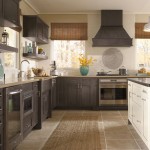What's new in kitchen remodeling?
There are lots of good cabinetry out there. But you have to be careful because some are not as good too. That's just the actual cabinet box that the door is attached to. The doors and drawer front are certainly the most expensive part of cabinetry and obviously the first thing you see. Then the drawer box is also a very important component. The hardware is often overlooked as a quality component, and then the finish also. Sometimes you see a cabinet finish, and it's brand new, and it's pretty, but you can't see the layers of paint. You can't see the quality of the clear coat. That's an area where it can be difficult for a homeowner to figure out, but we'll give you tips about how to judge a quality finish. Let’s find out what walks us through the different components and different names of a cabinet.
Cabinets can be done nicely, but essentially with a cabinet in a box. We can make things a bit more organized. The industry includes doors and drawers. You'll find there's a whole lot of things beyond that. You have the box depending on where the cabinet is in the run, you may or may not see any of the outsides of that box. It's in the middle and surrounded by cabinets with the countertop on top of it. Certainly, you want the cloud there for durability. That's kind of the structure that holds everything together. The drawer front and the door are important because that's what you look at and what you see, and then some of the other things. Also, we will mention different cabinet door styles.
As another element, the flooring traditionally is a base cabinet. The floor is roughly four to five inches from the floor. You don't have to bend over, and part of that is also to allow a toe-kick underneath when you're standing at the kitchen sink or just a counter area when you're slicing and dicing. You'll typically be wanting to get up a little closer. The standard in the industry is to give you about three and a half inches of space for your toes to fit underneath the bottom of the cabinet. Then you can stand a little closer. One of the ways you can adjust the height of a cabinet fairly easily to make your cabinet a little taller or a little shorter is very easy to change. We do that on-site while installing just by raising that up and down a little bit. But the toe-kick is an area as far as Americans with disabilities, accessible people with a wheelchair, then you want to have an eight-inch high toe kick so that the footrest of the wheelchair can fit under there. Also, you can do that with stock cabinetry where you don't like the counters. They are going to wind up being a little higher, or you can modify the cabinet to make that countertop height compliant while still getting that tall token. A couple of tiny things we would like to point out are the bumpers. All cabinet doors and drawers have bumpers, sometimes they're very cheap, and they're nicer. But when bumpers wear out and it kind of causes problems. That's a little detail to pay attention to when making your decision.
Different Quality Levels for Cabinetry
In general, we'd like to think of the best options when it comes to cabinetry. We generally consider cabinetry to be in a good category, semi-custom to be in a better category, and custom in the best category. That said, it's important to understand that there's also such a thing as:
- a good stock cabinet,
- a better stock cabinet,
- the best stock cabinet.
There is a good custom, a better custom, and an even better custom. Custom cabinets are going to be taken over a stock cabinet any day of the week. There are some pretty pure custom cabinets out there. There are also furniture-grade custom cabinets that are out of this world. It's important to understand that each category also has its good, better, and best. Let's dive into stock cabinetry.
There is a standard with the industry, even among semi-custom and custom. That cabinet work is generally in three-inch increments. We have to start at nine inches wide. A few of them might offer six-inch wide. Then you go every three inches up depending on the manufacturer some go to 36 some 45 feet. When you measure your wall for layout, you work in three-inch increments. If you have an inch and three-quarters leftover, then we wouldn't stock cabinets, you put in a filler piece. It's a piece of wood that matches the cabinetry. But generally, we try to put that at the end of the run or a torque turn in a corner so that it's not as noticeable. You should know that even in a nice home and a nice kitchen, there is nothing wrong with stock cabinetry. Only some compromises are made, and you're going to lose a little bit of space because we have to use more fillers. You won't have as many door options. One of the other things is that sometimes the door style you like is not available in the color you want. That also does happen. As the other point, one of the ways stock cabinet companies keep the price down is by limiting the number of choices. By limiting options, they can mass-produce parts and pieces, and that's less expensive. That does not necessarily mean the stock cabinets are of poor quality, but rather it means you have fewer options with a stock cabinet.
There's another point to bring up when we talk about the difference between stock semi-custom and custom. If we're going to keep bringing this up, it comes down to choices. There are quality options in each category. You've got more color choices and more door style choices. You also have more cabinet choices in semi-custom and custom than you do with the stock. Stock cabinets might start at around nine inches, a semi-custom cabinet, you could probably get a six-inch or three-inch pullout with more choices. Stock cabinets might only have one type of tall cabinet like that to choose from. A semi-custom is going to have six, ten, or twelve. It comes down to those kinds of choices of swell in the type of cabinet you have available to you. Then, of course, you can choose custom where they build whatever you want.
Credit: J&K Cabinetry
How to calculate kitchen cabinet costs
A lot of times, we're thinking of the price point on cabinets. It comes down to choices that you have as a big factor, as well as the quality construction. What we use predominantly, probably 85% of the cabinets we install are semi-custom. A couple of reasons for that are a lot more choices as far as door styles and finishes. As this first bullet point says, increments in sizing. They still start with a catalog of cabinets in three-inch increments. Let's say you need a cabinet that is 17 and a quarter inches. You're going to pay for an 18-inch cabinet, but then tell them to reduce it by three-quarters of the inch. It doesn't add a crazy amount of money to it, and just as the options that are a big deal, it becomes overwhelming. But that can be nice to have that kind of flexibility. That is the advantage there, especially when you're working with a professional designer who really knows the colors in any project. Once it comes to the colors, the hardest decision is making that first one. Once you pick one color that you can marry everything else around it. When you keep thinking about every option deeply you're never going to get anywhere. You need to make one decision and then pick a focal point and then work around it. There is a ton of value in cabinets for the vast majority of people. That quarter in sizing with no additional costs is great for the designer, and it gives you a lot of flexibility. As an example of some of the unique cabinets, you might get when you move up to a semi-custom line is that might not be available in a stock line. A couple I'd like to point out with certainty is a good custom builder. Your custom candidate builder should fit, form, and finish. You do want to work with a designer to help you design because they don't come in the standard sizes. You want to work with a designer who understands cabinet design, but you're looking at a much longer turnaround time. If we go with stock cabinetry because of their stock and warehouse, you can get stock cabinets in one to four weeks delivered to your door. You're looking at more like six to eight weeks, so a little bit longer. The semi-custom cabinets are built to order meaning they're not sitting in a warehouse somewhere. We order them, and then they start manufacturing the custom cabinets even longer. Eight weeks, 16 weeks, or 12 weeks. Then they do tend to be quite a bit more expensive, but you get whatever you want to a high degree of personalization, which is nice. If you are building a home and have a year, it might be a good option that could make more sense. One of the other things with custom is it's more like a piece of furniture. They're not thought of as modules in which stock cabinets are modular in semi-custom homes.
Finishes
To give you an idea that the gold standard of durable finishes these days is a UV catalyzed finish. It's a lacquer that they spray on the cabinet with a high-quality flatline spray system. When these things cost millions of dollars, then it's passed through UV light, and it catalyzes hardens that finish. It is difficult for custom shops to do that. Some do a very good job. But that can be one of the downsides too. This is something that you need to pay attention to when you're shopping around for custom finishes and cabinets.
Different Kitchen Cabinet Styles
Let’s start with frame versus frameless. You can use these kinds of styles for more traditional choices. Besides the frameless cabinetry, there is a framed cabinet style. Let's talk about the difference between framed and frameless. They both have a square box. That's where it starts, with a frameless box. You then put a door and a drone in front of it. Typically a frameless cabinet, the side panels, the floor, and the top are made out of a little bit thicker material. That way you have durability. One of the things that are important with any box seat you want to be able to keep it from racking if there's any pressure that comes against it. A lot of times these days the box is built, and then it goes from right there. A face frame typically is about an inch and a half wide and is a three-quarter inch thick of solid wood that gets applied to the front of the box. There are different ways of applying it. It could be a dowel joint or be a rabbet, dado, and mortise. But you want to make sure that it is on there good and secure because that's what the doors are going to hinge on. If the door is hanging on the face frame, but the face frame comes loose from the box, you still lost it. To be clear, in a framed cabinet, you can see before the door or frame goes on. They're both boxes, and they both have drawers. They're built pretty close to identically. Yet, the difference is the framed cabinet has a face frame, but the frameless cabinet doesn't instead. They would edge, and the edge of that box would have a finished edge with the frame cabinet. The frame is providing your finished edge. There is no big difference between framed versus frameless. But why do we care if we are framed or frameless? There are a few reasons you might choose one or the other. One of the reasons is; that frameless is without that frame. You actually get more storage, and you get more access to the cabinet. It reduces the opening size, and you've got this sort of skinnier drawer box. There's no frame, so you get a taller and a wider drawer box out of it. The framed cabinet has a full-frame in the face. But the only way to do an inset cabinet is you have to use it. You have to start with a framed cabinet. Paint plays an important role in preventing racking. It strengthens that cabinet box. Another way to do it is with these cleats that they put strapped across the top that reinforces the box. There are also other different cabinet styles, such as flat. That is a contemporary and modern style. There is also Raised, which is a more traditional door style. Another style is inset and is a flexible style that can convert from contemporary to more traditional style. You can just barely see every type of door style in our showroom. We have a wall of all the frames and for all cabinet door types. When you visit us, we can educate you on every detail. We need to educate our clients to give them an understanding of what their style is and how the process is being planned. You are always welcome in our showroom. You can book your appointment from our website, either a Zoom call or a showroom visit. We are here to help you.



























